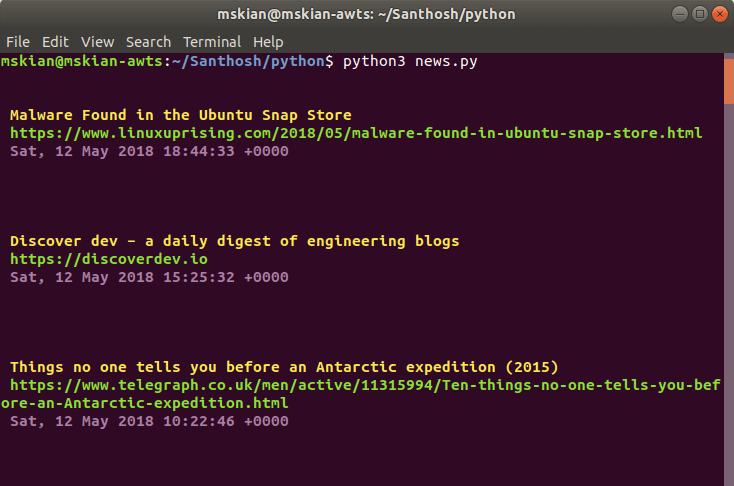

Let's move on to Google Colab for experimentation and testing.ĪDVERTISEMENT Step 1: How to extract the trending stocks news data Note: NER may not be a state-of-the-art problem but it has many applications in the industry. We'll then pull their market price data to test the authenticity of the news before taking any position in those stocks. We’ll get the textual data from RSS feeds on the internet and extract the names of buzzing stocks. The goal of this project is to learn and apply Named Entity Recognition to extract important entities (publicly traded companies in our example) and then link each entity with some information using a knowledge base (Nifty500 companies list). A virtual Python environment (I am using conda) along with libraries like Pandas, SpaCy, Streamlit, Streamlit-Spacy (if you want to show some SpaCy renders.).Source of stock market information (news) on which we’ll perform NER and later NEL.
RSS FEED READER PYTHON CODE
VS Code (or any editor) to code the Streamlit application.Google Colab for initial testing and exploration of data and the SpaCy library.So, let’s get on with it! Follow along and you’ll have a minimal stock news feed that you can start researching by the end of this tutorial.ĪDVERTISEMENT What you’ll need to get started: I’ll cover the important bits in more detail, so even if you’re a complete beginner you’ll be able to wrap your head around what’s going on. It would be helpful if you had some familiarity with Python and the basic tasks of NLP like tokenization, POS tagging, dependency parsing, and so on. There are no real pre-requisites as such. In this tutorial post, I’ll show you how you can leverage NEL to develop a custom stock market news feed that lists down the buzzing stocks on the internet. And we can use NER (or NEL - Named Entity Linking) in several domains like finance, drug research, e-commerce, and more for information retrieval purposes. Information retrieval has always been a major task and challenge in NLP. Uploading a document and getting the important bits of information from it is called information retrieval. Getting insights from raw and unstructured data is of vital importance. We've got too many agents to list all the links! You can find a link by picking your agent from the release notes page and then clicking the RSS icon.One of the very interesting and widely used applications of Natural Language Processing is Named Entity Recognition (NER). Or find the feed from the RSS link on the security bulletins page. Or find the feed from the RSS icon on What's New. We've got RSS for those too! Get a link to the feeds PT on Twitch) to ensure you know about the latest products and features directly from the product managers and engineers at New Relic who built them, and Nerd Bytes episodes on YouTube for quick tips, tricks, and ideas about New Relic and observability. We also release weekly Nerdlog episodes on YouTube (in case you miss our interactive livestream every Thursday at 12 p.m. (Want to create a Zapier workflow that turns your smart lightbulbs green every time we release a new Node.js agent? Go for it!)

Or go crazy with IFTTT or Zapier for all manner of RSS-based automation.

You can plug those feeds into your feed reader, of course, but you can also automatically post to a channel with Slack's built in RSS app or Microsoft Team's RSS app. Lately, we've seen lots of requests to add RSS for What's New and our security bulletins, so we've done just that! Now you can subscribe to all the newness New Relic has to offer.
RSS FEED READER PYTHON SOFTWARE
We've long had release note feeds for agents and downloadable software from the release notes page.

Have you heard? RSS is back! And we're on board.


 0 kommentar(er)
0 kommentar(er)
